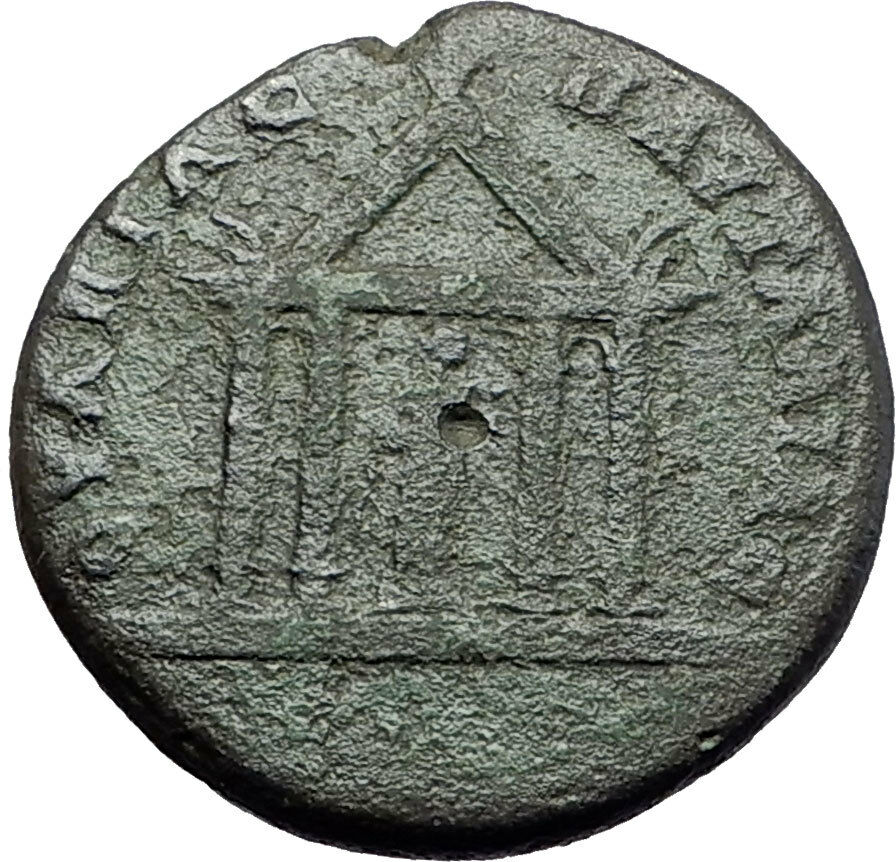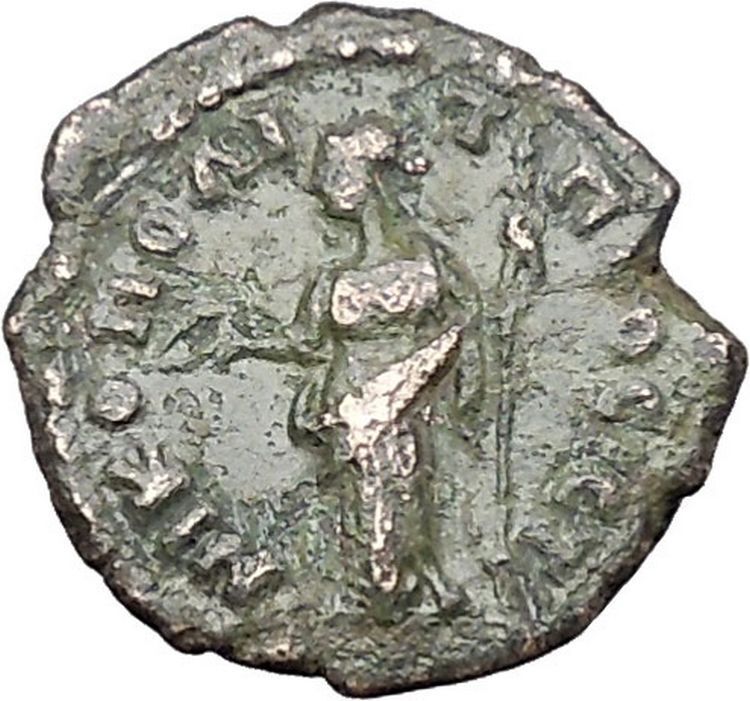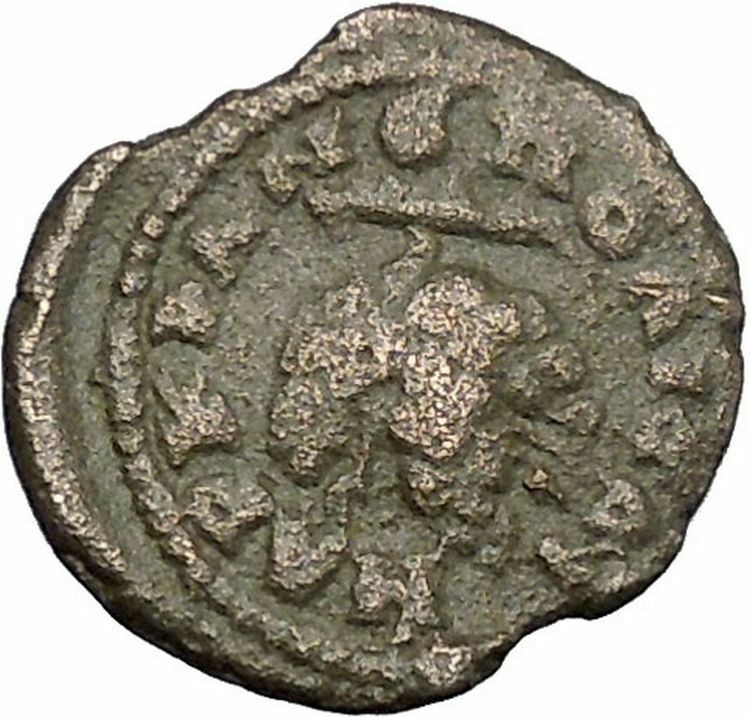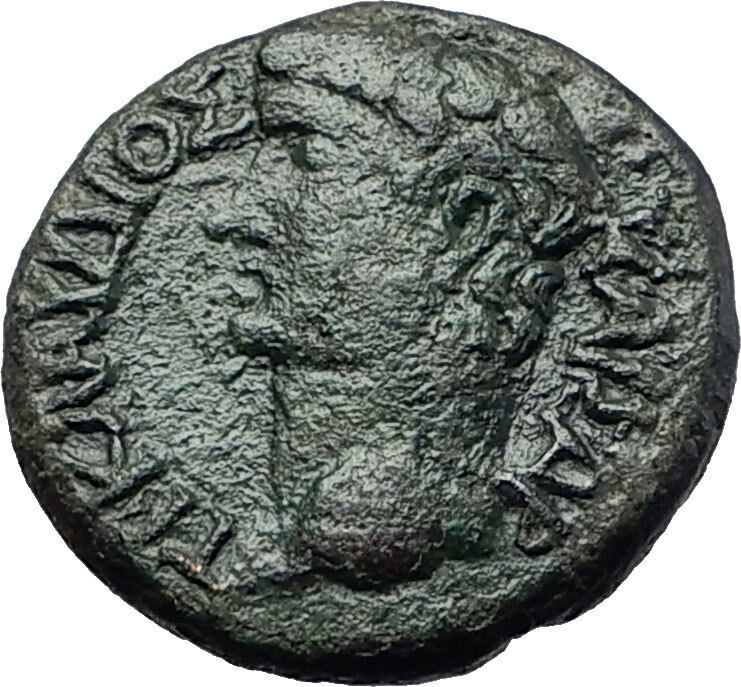|
Septimius Severus –
Roman Emperor: 193-211 A.D. –
Bronze 24mm (7.80 grams) of
Amphipolis in
Macedonia
Reference:
SNG ANS 197; Varbanov (cf. 3260-64; obverse legend).
Λ CEΠ CEBHPOC Π,
Laureate, draped and cuirassed bust right.
AMΦIΠOΛEITΩN,
City-godess (Tyche) seated left, wearing mural crown holding patera.
You are bidding on the exact item pictured,
provided with a Certificate of Authenticity and Lifetime Guarantee of
Authenticity.
Tyche (Greek for luck; the Roman equivalent was
Fortuna
) was the presiding
tutelary deity
that governed the fortune and
prosperity of a city, its destiny. Increasingly during the Hellenistic period,
cities had their own specific iconic version of Tyche, wearing a
mural crown
(a crown like the walls of the
city).

The
Greek historian Polybius
believed that when no cause can be
discovered to events such as floods, droughts, frosts or even in politics, then
the cause of these events may be fairly attributed to Tyche.
Stylianos Spyridakis concisely expressed Tyche’s appeal in a
Hellenistic world of arbitrary violence and unmeaning reverses: “In the
turbulent years of the
Epigoni of Alexander
, an awareness of the
instability of human affairs led people to believe that Tyche, the blind
mistress of Fortune, governed mankind with an inconstancy which explained the
vicissitudes of the time.”
In literature, she might be given various genealogies, as a daughter of
Hermes
and
Aphrodite
, or considered as one of the
Oceanids
, daughters of
Oceanus
and
Tethys
, or of
Zeus. She was connected with
Nemesis
and
Agathos Daimon
(“good spirit”).
She was uniquely venerated at
Itanos
in Crete, as Tyche Protogeneia,
linked with the Athenian
Protogeneia
(“firstborn”), daughter of
Erechtheus
, whose self-sacrifice saved the
city.
She had temples at
Caesarea Maritima
,
Antioch
,
Alexandria
and
Constantinople
. In
Alexandria
the Tychaeon, the temple of
Tyche, was described by
Libanius
as one of the most magnificent of the
entire Hellenistic world.
Tyche appears on many
coins
of the Hellenistic period in the three
centuries before the Christian era, especially from cities in the Aegean.
Unpredictable turns of fortune drive the complicated plotlines of
Hellenistic romances
, such as
Leucippe and Clitophon
or
Daphnis and Chloe
. She experienced a
resurgence in another era of uneasy change, the final days of publicly
sanctioned
Paganism
, between the late-fourth-century
emperors
Julian
and
Theodosius I
who definitively closed the
temples. The effectiveness of her capricious power even achieved respectability
in philosophical circles during that generation, though among poets it was a
commonplace to revile her for a fickle harlot.
In medieval art
, she was depicted as carrying a
cornucopia
, an
emblematic
ship’s rudder, and the
wheel of fortune
, or she may stand on the
wheel, presiding over the entire circle of fate.
The constellation of
Virgo
is sometimes identified as the heavenly
figure of Tyche, as well as other goddesses such as
Demeter
and
Astraea
.
Amphipolis was an
ancient
Greek
city
in the region once inhabited by the
Edoni
people in the present-day
periphery
of
Central Macedonia
. It was built on a raised
plateau overlooking the east bank of the
river
Strymon
where it emerged from Lake Cercinitis,
about 3 m. from the
Aegean Sea
. Founded in 437 BC, the city was
finally abandoned in the 8th century AD. The present municipality Amfipoli,
named after the ancient city, occupies the site. Currently, it is a municipality
in the
Serres Prefecture
,
Central Macedonia
with a population of 3,623
(2001 census).
Origins
Archaeology
has uncovered remains at the site
dating to approximately 3000 BC. Due to the strategic location of the site it
was fortified from very early.
Xerxes I
of Persia
passed during his invasion of Greece
of 480 BC and buried alive nine young men and nine maidens as a sacrifice to the
river god. Near the later site of Amphipolis
Alexander I
of Macedon
defeated the remains of Xerxes’ army
in 479 BC.
Throughout the 5th century BC,
Athens
sought to consolidate its control over
Thrace, which was strategically important because of its primary materials (the
gold and silver of the
Pangaion hills
and the dense forests essential
for naval construction), and the sea routes vital for Athens’ supply of grain
from Scythia
. After a first unsuccessful attempt at
colonisation in 497 BC by the
Miletian
Tyrant
Histiaeus
, the Athenians founded a first colony
at Ennea-Hodoi (‘Nine Ways’) in 465, but these first ten thousand colonists were
massacred by the
Thracians
. A second attempt took place in 437
BC on the same site under the guidance of
Hagnon
, son of
Nicias
.
The new settlement took the name of Amphipolis (literally, “around the
city”), a name which is the subject of much debates about
lexicography
.
Thucydides
claims the name comes from the fact
that the Strymon flows “around the city” on two sides; however a note in the
Suda (also given in the lexicon of
Photius
) offers a different explanation
apparently given by
Marsyas
, son of
Periander
: that a large proportion of the
population lived “around the city”. However, a more probable explanation is the
one given by
Julius Pollux
: that the name indicates the
vicinity of an isthmus
. Furthermore, the
Etymologicum Genuinum
gives the following
definition: a city of the Athenians or of Thrace, which was once called Nine
Routes, (so named) because it is encircled and surrounded by the Strymon river.
This description corresponds to the actual site of the city (see adjacent map),
and to the description of Thucydides.
Amphipolis subsequently became the main power base of the Athenians in Thrace
and, consequently, a target of choice for their
Spartans
adversaries. The Athenian population
remained very much in the minority within the city. An Athenian rescue
expedition led by strategist (and later historian) Thucydides had to settle for
securing Eion
and could not retake Amphipolis, a failure
for which Thucydides was sentenced to exile. A new Athenian force under the
command of Cleon
failed once more in 422 BC during a
battle
at which both
Cleon
and
Brasidas
lost their lives. Brasidas survived
long enough to hear of the defeat of the Athenians and was buried at Amphipolis
with impressive pomp. From then on he was regarded as the founder of the city
and honoured with yearly games and sacrifices. The city itself kept its
independence until the reign of the king
Philip II
despite several other Athenian
attacks, notably because of the government of
Callistratus
of Aphidnae
.
Conquest
by the Romans
In 357 BC, Philip removed the block which Amphipolis presented on the road to
Macedonian control over Thrace by conquering the town, which Athens had tried in
vain to recover during the previous years. According the historian
Theopompus
, this conquest came to be the object
of a secret accord between
Athens
and Philip II, who would return the city
in exchange for the fortified town of
Pydna
, but the Macedonian king betrayed the
accord, refusing to cede Amphipolis and laying siege to Pydna.
After the conquest by Philip II, the city was not immediately incorporated
into the kingdom, and for some time preserved its institutions and a certain
degree of autonomy. The border of Macedonia was not moved further east; however,
Philip sent a number of Macedonians governors to Amphipolis, and in many
respects the city was effectively ‘Macedonianized’. Nomenclature, the calendar
and the currency (the
gold stater
, installed by Philip to capitalise
on the gold reserves of the Pangaion hills, replaced the Amphipolitan
drachma
) were all replaced by Macedonian
equivalents. In the reign of
Alexander
, Amphipolis was an important naval
base, and the birthplace of three of the most famous Macedonian
Admirals
:
Nearchus
, Androsthenes[6]
and
Laomedon
whose burial place is most likely
marked by the famous lion of Amphipolis.
Amphipolis became one of the main stops on the Macedonian royal road (as
testified by a border stone found between
Philippos
and Amphipolis giving the distance to
the latter), and later on the ‘Via
Egnatia’, the principal
Roman Road
which crossed the southern Balkans.
Apart from the ramparts of the low town (see photograph), the gymnasium and a
set well-preserved frescoes from a wealthy villa are the only artifacts from
this period that remain visible. Though little is known of the layout of the
town, modern knowledge of its institutions is in considerably better shape
thanks to a rich epigraphic documentation, including a military ordinance of
Philip V
and an
ephebarchic
law from the gymnasium. After the
final victory of
Rome
over Macedonia in a
battle
in 168 BC, Amphipolis became the capital
one of the four mini-republics, or ‘merides’, which were created by the Romans
out of the kingdom of the
Antigonids
which
succeeded
Alexander’s Empire in Macedon. These
‘merides’ were gradually incorporated into the Roman client state, and later
province, of Thracia
.
Revival
in Late Antiquity
During the period of
Late Antiquity
, Amphipolis benefited from the
increasing economic prosperity of Macedonia, as is evidenced by the large number
of Christian Churches
that were built.
Significantly however, these churches were built within a restricted area of the
town, sheltered by the walls of the
acropolis
. This has been taken as evidence that
the large fortified perimeter of the ancient town was no longer defendable, and
that the population of the city had considerably diminished.
Nevertheless, the number, size and quality of the churches constructed
between the fifth and sixth centuries are impressive. Four
basilicas
adorned with rich
mosaic
floors and elaborate architectural
sculptures (such as the ram-headed
column
capitals – see picture) have been
excavated, as well as a church with a hexagonal central plan which evokes that
of the
basilica
of
St. Vitalis
in
Ravenna
. It is difficult to find reasons for
such municipal extravagance in such a small town. One possible explanation
provided by the historian
André Boulanger
is that an increasing
‘willingness’ on the part of the wealthy upper classes in the late Roman period
to spend money on local
gentrification
projects (which he terms ‘’évergétisme’’,
from the Greek verb εύεργετέω,(meaning ‘I do good’) was exploited by the local
church to its advantage, which led to a mass gentrification of the urban centre
and of the agricultural riches of the city’s territory. Amphipolis was also a
diocese
under the
suffragan
of
Thessaloniki
– the Bishop of Amphipolis is
first mentioned in 533 AD.
From
the reduction of the urban area to the disappearance of the city
The
Slavic invasions
of the late 6th century
gradually encroached on the back-country Amphipolitan lifestyle and led to the
decline of the town, during which period its inhabitants retreated to the area
around the acropolis. The ramparts were maintained to a certain extent, thanks
to materials plundered from the monuments of the lower city, and the large
unused cisterns of the upper city were occupied by small houses and the
workshops of artisans. Around the middle of the 7th century AD, a further
reduction of the inhabited area of the city was followed by an increase in the
fortification of the town, with the construction of a new rampart with
pentagonal towers cutting through the middle of the remaining monuments. The
acropolis, the Roman baths
, and especially the Episcopal
basilica were crossed by this wall.
The city was probably abandoned in the eighth century, as the last bishop was
attested in 787. Its inhabitants probably moved to the neighbouring site of
ancient Eion
, port of Amphipolis, which had been
rebuilt and refortified in the
Byzantine period
under the name “Chrysopolis”.
This small port continued to enjoy some prosperity, before being abandoned
during the
Ottoman period
. The last recorded sign of
activity in the region of Amphipolis was the construction of a fortified tower
to the north in 1367 by
Grand Primicier
Jean and the
Stratopedarque
Alexis to protect the land that
they had given to the monastery of Pantokrator on
Mount Athos
.
Archaeology
The site was rediscovered and described by many travellers and archaeologists
during the 19th century, including E. Cousinéry (1831) (engraver), L. Heuzey
(1861), and P. Perdrizet (1894–1899). In 1934, M. Feyel, of the
École française d’Athènes
, led an
epigraphical mission
to the site and uncovered
the remains of a funeral lion (a reconstruction was given in the, a publication
of the EfA which is available on line). However, excavations did not truly begin
until after the Second World War. The
Greek Archaeological Society
under D. Lazaridis
excavated in 1972 and 1985, uncovering a necropolis, the rampart of the old town
(see photograph), the basilicas, and the acropolis.
Amphipolitans
-
Demetrius of Amphipolis
, student of Plato’s
- Zoilus
(400 BC-320 BC), grammarian, cynic
philosopher
-
Pamphilus (painter)
, head of
Sicyonian
school and teacher of
Apelles
- Aetion
, sculptor
-
Philippus of Amphipolis
, historian
- Nearchus
, admiral
- Erigyius
, general
- Damasias
[disambiguation
needed] of Amphipolis 320 BC
Stadion
Olympics
-
Hermagoras of Amphipolis
(c. 225 BC), stoic
philosopher ,follower of
Persaeus
- Xena
, the Warrior Princess of Amphipolis.
Septimius Severus –
Roman Emperor: 193-211 A.D.
 Augustus: 193-211 A.D. | 193-198 A.D. Sole reign; 195-198 Augustus: 193-211 A.D. | 193-198 A.D. Sole reign; 195-198
A.D.
Caracalla as Caesar | 198-209 A.D. with
Caracalla;
Geta as Caesar | 209-211
A.D. with
Caracalla and
Geta
Husband of
Julia Domna
| Father of
Caracalla and
Geta
| Uncle of
Julia Soaemias and
Julia Mamaea | Great-uncle of
Elagabalus and
Severus Alexander | Brother-in-law of
Julia Maesa | Father-in-law of
Plautilla |
Lucius Septimius Severus (or rarely Severus I) (April 11,
145/146-February 4, 211) was a
Roman
general, and
Roman
Emperor
from April 14, 193 to 211. He was born in what is now the
Berber
part of
Rome’s historic
Africa Province
.
Septimius Severus was born and raised at
Leptis
Magna
(modern Berber
, southeast of
Carthage
,
modern Tunisia
).
Severus came from a wealthy, distinguished family of
equestrian
rank. Severus was of
Italian
Roman ancestry on his mother’s side and of
Punic
or
Libyan
-Punic
ancestry on his father’s. Little is known of his father,
Publius Septimius Geta
, who held no major political status but had two
cousins who served as consuls under emperor
Antoninus Pius
. His mother, Fulvia Pia’s family moved from
Italy
to
North
Africa
and was of the
Fulvius
gens,
an ancient and politically influential clan, which was originally of
plebeian
status. His siblings were a younger
Publius Septimius Geta
and Septimia Octavilla. Severus’s maternal cousin was
Praetorian Guard
and consul
Gaius Fulvius Plautianus
.
In 172, Severus was made a
Senator
by the then emperor
Marcus Aurelius
. In 187 he married secondly
Julia
Domna
. In 190 Severus became
consul
, and in
the following year received from the emperor
Commodus
(successor to Marcus Aurelius) the command of the
legions
in Pannonia
.
On the murder of
Pertinax
by
the troops in 193, they proclaimed Severus Emperor at
Carnuntum
,
whereupon he hurried to Italy. The former emperor,
Didius Julianus
, was condemned to death by the Senate and killed, and
Severus took possession of Rome without opposition.
The legions of
Syria
, however, had proclaimed
Pescennius Niger
emperor. At the same time, Severus felt it was reasonable
to offer
Clodius Albinus
, the powerful governor of Britannia who had probably
supported Didius against him, the rank of Caesar, which implied some claim to
succession. With his rearguard safe, he moved to the East and crushed Niger’s
forces at the
Battle of Issus
. The following year was devoted to suppressing Mesopotamia
and other Parthian vassals who had backed Niger. When afterwards Severus
declared openly his son
Caracalla
as successor, Albinus was hailed emperor by his troops and moved to Gallia.
Severus, after a short stay in Rome, moved northwards to meet him. On
February
19
, 197
,
in the
Battle of Lugdunum
, with an army of 100,000 men, mostly composed of
Illyrian
,
Moesian
and
Dacian
legions,
Severus defeated and killed Clodius Albinus, securing his full control over the
Empire.
Emperor
Severus was at heart a
soldier
, and
sought glory through military exploits. In 197 he waged a brief and successful
war against the
Parthian Empire
in retaliation for the support given to Pescennius Niger.
The Parthian capital
Ctesiphon
was sacked by the legions, and the northern half of
Mesopotamia
was restored to Rome.
His relations with the
Roman
Senate
were never good. He was unpopular with them from the outset, having
seized power with the help of the military, and he returned the sentiment.
Severus ordered the execution of dozens of Senators on charges of corruption and
conspiracy
against him, replacing them with his own favorites.
He also disbanded the
Praetorian Guard
and replaced it with one of his own, made up of 50,000
loyal soldiers mainly camped at
Albanum
, near Rome (also probably to grant the emperor a kind of centralized
reserve). During his reign the number of legions was also increased from 25/30
to 33. He also increased the number of auxiliary corps (numerii), many of
these troops coming from the Eastern borders. Additionally the annual wage for a
soldier was raised from 300 to 500
denarii
.
Although his actions turned Rome into a military
dictatorship
, he was popular with the citizens of Rome, having stamped out
the rampant corruption of Commodus’s reign. When he returned from his victory
over the Parthians, he erected the
Arch of Septimius Severus
in Rome.
According to Cassius Dio,
however, after 197 Severus fell heavily under the influence of his Praetorian
Prefect,
Gaius Fulvius Plautianus
, who came to have almost total control of most
branches of the imperial administration. Plautianus’s daughter,
Fulvia Plautilla
, was married to Severus’s son, Caracalla. Plautianus’s
excessive power came to an end in 205, when he was denounced by the Emperor’s
dying brother and killed.
The two following praefecti, including the jurist
Aemilius Papinianus
, received however even larger powers.
Campaigns in Caledonia (Scotland)
Starting from 208 Severus undertook a number of military actions in
Roman
Britain
, reconstructing
Hadrian’s Wall
and campaigning in
Scotland
.
He reached the area of the
Moray
Firth
in his last campaign in Caledonia, as was called Scotland by
the Romans..
In 210 obtained a peace with the
Picts
that lasted
practically until the final withdrawal of the Roman legions from Britain,
before falling severely ill in
Eboracum
(York).
Death
He is famously said to have given the advice to his sons: “Be harmonious,
enrich the soldiers, and scorn all other men” before he died at Eboracum on
February 4
,
211. Upon his death in 211, Severus was
deified
by the Senate and succeeded by his sons,
Caracalla
and
Geta
, who were advised by his wife
Julia
Domna
. The stability Severus provided the Empire was soon gone under their reign.
Accomplishments and Record
Though his military expenditure was costly to the empire, Severus was the
strong, able ruler that Rome needed at the time. He began a tradition of
effective emperors elevated solely by the military. His policy of an expanded
and better-rewarded army was criticized by his contemporary
Dio Cassius
and
Herodianus
: in particular, they pointed out the increasing burden (in the
form of taxes and services) the civilian population had to bear to maintain the
new army.
Severus was also distinguished for his buildings. Apart from the triumphal
arch in the Roman Forum carrying his full name, he also built the
Septizodium
in Rome and enriched greatly his native city of
Leptis
Magna
(including another triumphal arch on the occasion of his visit of
203).
Severus and Christianity
Christians were
persecuted
during the reign of Septimus Severus. Severus allowed the
enforcement of policies already long-established, which meant that Roman
authorities did not intentionally seek out Christians, but when people were
accused of being Christians they could either curse
Jesus
and make an
offering to
Roman gods
, or be executed. Furthermore, wishing to strengthen the peace by
encouraging religious harmony through
syncretism
,
Severus tried to limit the spread of the two quarrelsome groups who refused to
yield to syncretism by outlawing
conversion
to Christianity or
Judaism
.
Individual officials availed themselves of the laws to proceed with rigor
against the Christians. Naturally the emperor, with his strict conception of
law, did not hinder such partial persecution, which took place in
Egypt
and the
Thebaid
, as
well as in
Africa proconsularis
and the East. Christian
martyrs
were
numerous in Alexandria
(cf.
Clement of Alexandria
, Stromata, ii. 20;
Eusebius
, Church History, V., xxvi., VI., i.). No less severe were
the persecutions in Africa, which seem to have begun in 197 or 198 (cf.
Tertullian’s
Ad martyres), and included the Christians known in the
Roman martyrology
as the martyrs of
Madaura
.
Probably in 202 or 203
Felicitas
and
Perpetua
suffered for their faith. Persecution again raged for a short time
under the proconsul
Scapula
in
211, especially in
Numidia
and
Mauritania
.
Later accounts of a Gallic
persecution, especially at
Lyon, are
legendary. In general it may thus be said that the position of the Christians
under Septimius Severus was the same as under the
Antonines
;
but the law of this Emperor at least shows clearly that the
rescript
of
Trajan
had failed to execute its purpose.
|






 Augustus: 193-211 A.D. | 193-198 A.D. Sole reign; 195-198
Augustus: 193-211 A.D. | 193-198 A.D. Sole reign; 195-198 


